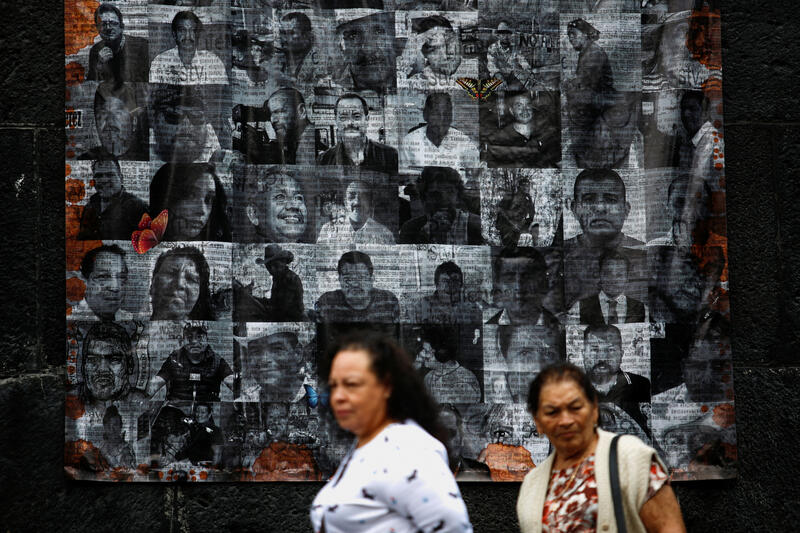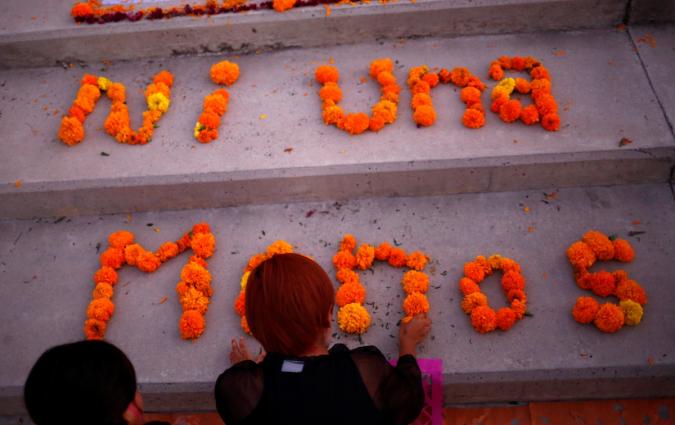In this piece
The press vs. organised crime: lessons from Mexico for Argentina

People walk by pictures of murdered journalists and activists displayed on an altar on the eve of the Day of the Dead in Mexico City, Mexico, October 31, 2022. (Image: REUTERS/Gustavo Graf)
In this piece
In context: criminality in Mexico | In context: criminality in Argentina | Securing journalists' safety: A three-prong approach | Conclusion | Staying safe: 10 useful guides and manuals for Argentinian journalistsWhen clashes erupted yet again in January 2023 between members of the Sinaloa cartel and security forces in Culiacán, Mexico, the armed gangsters harassed and assaulted journalists covering the events, stealing their vehicles and equipment, and threatening to kill them.
With a long history of high-profile cases, this type of violence against media is all too familiar terrain for the Mexican press corps. By contrast, when a similar story unfolded in Argentina’s Rosario one week prior, journalists there were aghast.
News reporters at Televisión Litoral narrowly escaped tragedy on 29 December 2022, when a masked assailant opened fire on the studio complex. It was the second drive-by shooting targeting the station in 17 days, highlighting the growing threat organised crime poses for journalists in Argentina.
With organised crime on the increase in Argentina, I wanted to spend my time as a journalist fellow at the Reuters Institute seeing what lessons we could take from our Mexican peers to mitigate the risk of violence in the line of duty.
To do so, I reviewed existing resources and interviewed experts to present a three-prong multiparty approach to improving the safety of journalists nationally, and a three-dimensional journalists’ support plan for newsrooms to implement internally.
In context: criminality in Mexico
In August 2022, four Mexican journalists were murdered in a span of four weeks, marking it as the deadliest month for the profession. Reporters Without Borders (RSF) demanded a comprehensive policy to ensure the safety of information professionals, whose role is crucial for Mexican democracy.
General violence has spiralled in Mexico since former president Felipe Calderon declared a war against drug trafficking organisations in 2007. By 2022, Mexico recorded 33,287 homicides, with a staggering 94.8% of these crimes going unpunished. To put this in perspective, compare it to Indonesia – a state with similar land size and GPD, but almost double the population – which recorded 854 homicides in 2022. Mexico’s figures are a direct result of the weak institutional response to violence, underscoring the precarious situation for journalists.
In context: criminality in Argentina
Argentina is experiencing a rise in domestic drug consumption, strengthening criminal clans and expanding their influence. In central Argentina, specifically in the south of Santa Fe province, various criminal groups are fighting for control of drug commerce and distribution. FOPEA, the Argentine Journalism Forum, reported in May 2023 that 60% of attacks against journalists in Santa Fe in 2022 were related to organised crime. This correlation between criminal activity and violence against journalists is alarming, with explicit death threats and drive-by shootings becoming more frequent.
Securing journalists' safety: A three-prong approach
1. The duty of the state to protect free press Artur Romeu, director of the Latin America bureau of RSF, emphasised that states must create a safer environment for journalism. In Colombia, the National Protection Unit (UNP) administers a comprehensive protection mechanism that involves 6,000 people and has a budget of $300 million. However, the RSF report titled "Protection Paradigm" revealed significant structural flaws in these systems, including reliance on inefficient institutions and inadequate protection measures.
2. The duty of media companies to protect their workers Media companies often neglect their responsibility to protect journalists due to the associated costs. Elda Cantú, an editor for the New York Times, highlighted the importance of supportive management in ensuring journalists' safety. It is essential for media organisations to develop written protocols and strategies to safeguard their workers, including risk analysis and preventive measures.
3. Self-organisation and collective bargaining of journalists The self-organisation of journalists is crucial in advocating for safety rights and securing adequate protection resources. Forming unions or associations strengthens their bargaining power and creates networks of mutual support. The CPJ’s Journalist Security Guide notes that collaborative efforts can provide alternative ways to publish dangerous stories, effectively diffusing risk. Examples from Colombia, such as the collaboration between El Espectador and other media outlets, demonstrate the effectiveness of this approach.
Three dimensions of safety integrity in newsrooms
1. Physical integrity Ensuring physical integrity involves providing secure work environments and necessary resources, such as protective gear and adequate training. All too often, editors view physical safety through the lens of covering violent conflict, but RSF advocates for a more holistic approach that includes training for all and informed and supportive management practices. Azam Ahmed, a former New York Times Mexico bureau chief, stressed the importance of situational awareness and collaboration with local journalists to maintain safety.
2. Emotional integrity Recognising the emotional toll of journalistic work is vital. Media organisations should prioritise emotional support services and encourage a healthy work-life balance. Journalists can take control here too, by limiting exposure to toxic social media environments and taking breaks.
3. Communications’ integrity Protecting the confidentiality of communications is paramount. Journalists should use strong passwords, encryption tools, and secure communication channels to safeguard sensitive information and sources. Regular training in the evolving techniques of digital security practices is essential.
Conclusion
Latin American journalists have spent decades developing countless strategies and resources for dealing with organised crime. Thanks to their efforts, we know that mutual aid, solidarity, and coordinated action are essential for surviving violent contexts without relinquishing the task of informing.
Yet the continued murders, disappearances, torture, and harassment of journalists – particularly in countries like Mexico, Colombia, and Brazil – highlight that the efforts of the press alone are insufficient to safeguard freedom of expression.
Without the commitment and intervention of governments, media companies, civil society organisations, and society as a whole, journalists will remain targets of criminal gangs seeking to carry out their illicit business in the silence of terror.
Robust journalism is essential for a healthy democracy, and the safety and security of journalists is not a “nice to have”, it is a “must have”. Argentinian journalists, who work in an increasingly challenging and hostile environment, can learn from the experience of their Latin American colleagues. But they must not fall prey to believing safety is their burden to bear alone.
Staying safe: 10 useful guides and manuals for Argentinian journalists
- Rosario Press Workers Union. A guide to minimizing risks. Available in Spanish.
- Voces del Sur. Security manual for covering social protests. Available in Spanish.
- ARTÍCULO 19. Comprehensive security for journalists. Available in Spanish.
- Acos Alliance. Take control of your security. Available in Spanish.
- Committee to Protect Journalists. Journalist Security Guide: Covering the news in a dangerous and changing world. Available in English and Spanish.
- Reporters Without Borders. Safety Guide for Journalists: A handbook for reporters in high-risk environments. Available in English and Spanish.
- UNESCO. Safety of journalists covering protests: preserving freedom of the press during times of turmoil. Available in English and Spanish.
- Security-in-a-Box. Tools and tactics for digital security, in English and Spanish.
- Global Investigative Journalism Network. Basic steps in digital security for journalists. Available in English and Spanish.
This project and fellowship have been made possible by the support of the Thomson Reuters Foundation.


